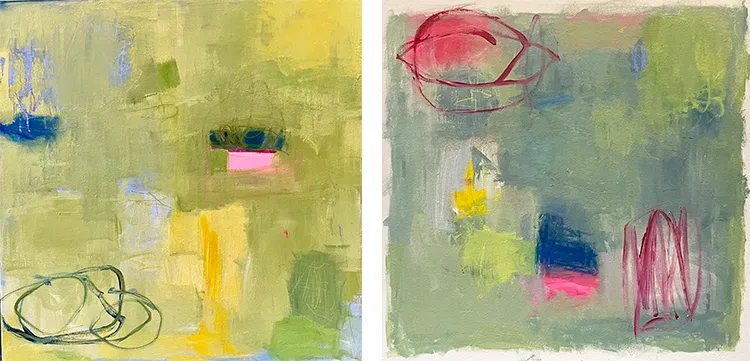“I make intuitive abstract art. What propels me forward is the process itself, the lack of pre designed outcome. This is so very different from my… training as a lawyer.”
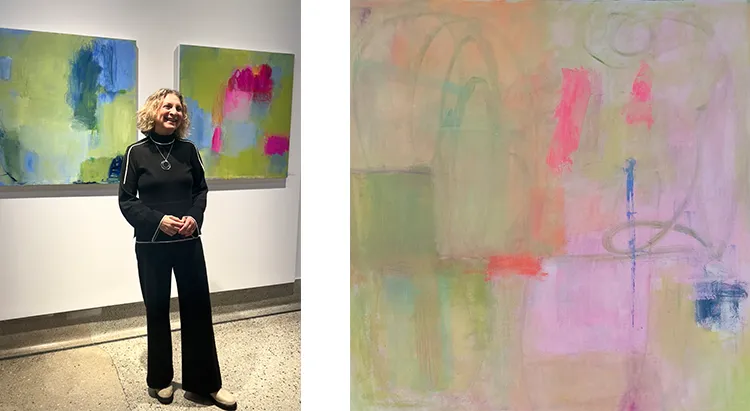
Shaping a Life Through Creativity
Soraya Farha, a Canadian artist of Lebanese descent, has cultivated a unique artistic voice rooted in her heritage, experiences of displacement, and a life shaped by creativity. Born in the 1960s, she was immersed in a world that challenged conventions, both culturally and personally. Her upbringing was rich in creative influences, with a mother who introduced her to world literature, diverse cuisines, and puppet-making, and a father whose poetic way of speaking in Arabic instilled a love for language and metaphor. The family’s moves between Canada and Greece in the midst of her parents’ separation added an element of travel and adaptation to Farha’s life, exposing her to a variety of cultural landscapes.
Farha’s early years were marked by a sense of creative independence. During extended stays in Greece, with little else to occupy her time, she and her sisters turned to reading, writing, and artistic exploration. These experiences would later form the foundation of her artistic sensibilities. Childhood encounters with both the spoken and visual arts primed her for a life steeped in creativity, yet it wasn’t until later in adulthood, after the loss of her sister, that Farha embraced her identity as a “creative.” This personal tragedy awakened in her an urgency to express the emotions and memories that words alone could not convey, pushing her toward a more deliberate exploration of artistic forms.
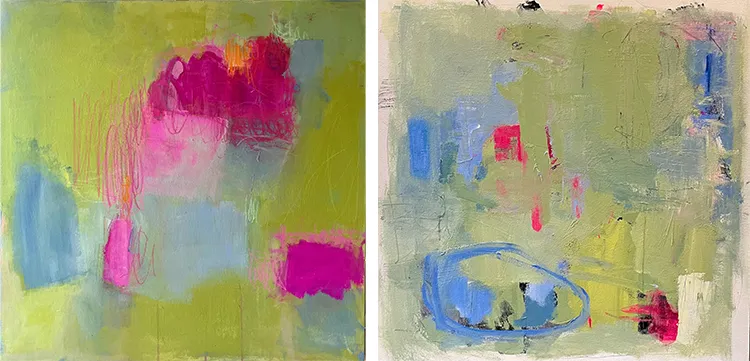
Soraya Farha: Art as a Response to Loss
The death of Farha’s sister in 2011 proved to be a pivotal moment, catalyzing her transformation into a visual artist. The grief she experienced felt insurmountable, leading her to question whether she could ever again find beauty in the world. She turned to Cheryl Strayed’s memoir Wild for guidance, resonating deeply with the idea that one must actively “put oneself in the way of beauty.” Initially, Farha began documenting beauty through photography, sharing her daily images on social media, but soon this simple act was not enough to channel the intensity of her emotions. Her desire to create something tangible became overwhelming, prompting her to explore visual art more deeply.
With no formal training, Farha threw herself into learning various artistic techniques, starting with drawing and pastel work before moving into acrylic painting. She took an intuitive, self-guided approach, experimenting with layers, colors, and textures, gradually incorporating different media such as graphite and oil sticks. What emerged from this process was a form of abstract art that resisted fixed outcomes. Farha’s work became an embodiment of her emotional and psychological journey, a reflection of her internal world that unfolded naturally without a predetermined design. The process itself—layering, scraping, and revealing hidden forms—mirrored her personal experience of coping with loss, as she found solace in the unpredictable beauty of the creative act.
Farha’s dual career as a lawyer informed her artistic process in surprising ways. Her ability to structure arguments and organize evidence echoed in her artistic compositions. The act of building a painting, layer by layer, felt akin to constructing a legal case, drawing connections between seemingly unrelated pieces to form a cohesive whole. Yet, in art, the logic fell away, leaving room for a more instinctual and often subconscious process to take over.
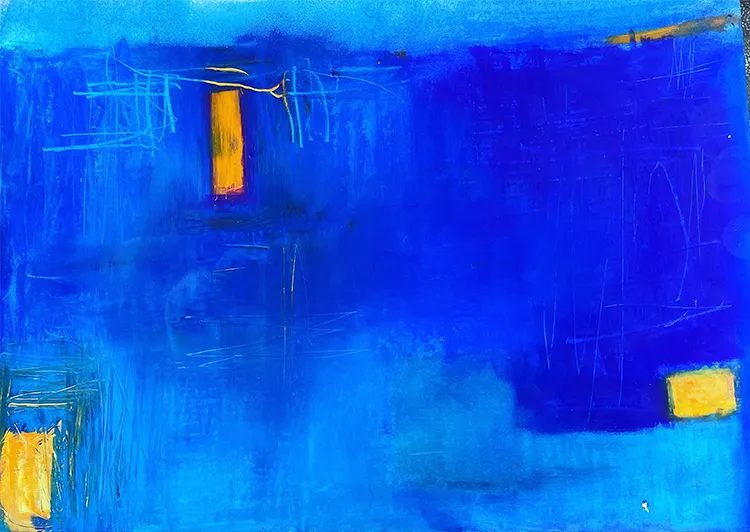
The Interplay of Art, Music, and Literature
For Farha, creativity does not exist in isolation. Her work draws heavily from other artistic disciplines, such as music and poetry, reflecting her deep appreciation for the interconnectedness of different forms of expression. She speaks passionately about how music, in particular, plays an integral role in her painting process. Whether it’s finding the perfect piece of music to pair with a finished painting or using a song’s mood to inform the direction of her work, Farha views these artistic intersections as essential to her creative practice. This blending of art forms allows her to transcend the boundaries of any single medium, creating a rich, multi-sensory experience for both herself and her audience.
Titles are equally important in Farha’s work, often drawing from poetry or song lyrics that resonate with the themes of her pieces. Sometimes, the titles come to her only after the artwork is finished, as if the painting itself uncovers the words that were hidden in her subconscious. This process, like her painting, is intuitive and reveals the seamless relationship between visual and verbal language in her practice. Through these artistic dialogues, Farha demonstrates that her art is not just about creating isolated works but about weaving together a broader tapestry of emotional and intellectual expression.
Her admiration for artists such as Joan Mitchell, Etel Adnan, and Wolf Kahn reflects her appreciation for those who also explore the merging of different artistic forms. Farha is particularly drawn to Adnan, a fellow Lebanese artist, whose work resonates with Farha’s own sense of belonging to multiple cultures. Adnan’s ability to evoke landscapes and memories with minimalistic forms has deeply influenced Farha, both in her approach to abstraction and in her contemplation of her own cultural identity.
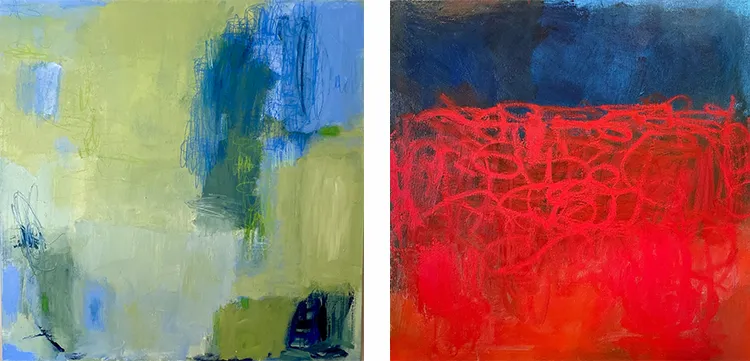
Soraya Farha: Crafting Art from Family and Memory
Farha’s creative journey is deeply personal, often intertwined with her family’s history and the objects that carry their memories. Her Lebanese roots and her family’s culinary traditions play a significant role in her artistic vision. She is currently developing a project that involves creating art from her extensive collection of cookbooks, each marked with inscriptions, notes, and recipes passed down from her family members. These artifacts tell the story of her family’s migration, the bonds formed over shared meals, and the deep connection she feels to her heritage. For Farha, the act of transforming these everyday objects into art is a way to preserve and honor her family’s legacy.
The idea for this project stems from the notion that food, like art, carries stories and memories within it. Farha’s collection includes recipes from her late sister, instructions from her father on how to make traditional dishes like homemade yogurt, and handwritten notes from her mother. Together, these culinary artifacts represent a tangible link to the past, one that Farha hopes to capture and reflect in her visual work. She sees this project not only as a personal exploration but as a universal meditation on family, memory, and the passage of time.
As she contemplates the future, Farha remains dedicated to this project, believing that these everyday objects—recipes, cookbooks, and kitchen notes—have the power to tell the story of who she is and where she comes from. Through this creative process, she continues to explore the themes of loss, memory, and identity that have shaped her life and her art. In doing so, Soraya Farha’s work becomes not only a reflection of her personal journey but a testament to the enduring power of art to connect us to our past and guide us toward our future.
